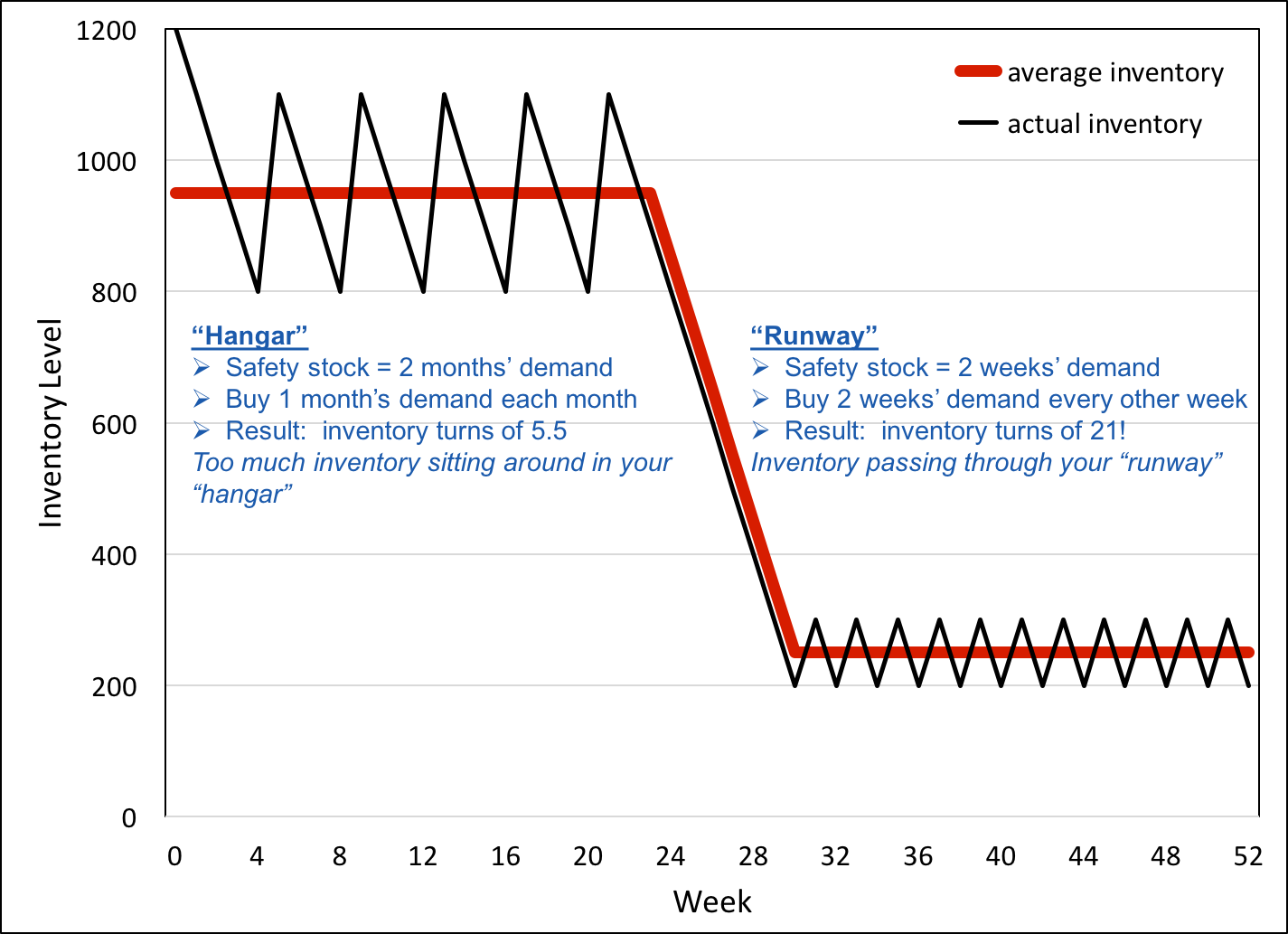Categories: Inventory Management
By Mark Tomalonis
Principal, WarehouseTWO, LLC
October 2016
 I will make this clear right up front: this is an article about how to improve inventory turns…
I will make this clear right up front: this is an article about how to improve inventory turns…
On average, there are over 600 commercial airliner landings per day at WarehouseTWO’s local airport, San Francisco International Airport (SFO). But there is not nearly enough hangar space at SFO to store that many planes. How does SFO handle its large volume of incoming planes? Easy: on average there are over 600 takeoffs from SFO too. Like all major airports, SFO is essentially a runway by which planes come and go. Typically, planes stay on the ground for less than two hours. No hangar needed. Airports have incredibly high inventory turns.
How does your company handle the volume of products being bought and sold? On average, does your inventory stay in your warehouse for two hours, two months or two years? Are your inventory turns as high as you would like them to be? Is your warehouse a hangar or a runway? To learn how to make your warehouse act less like a hangar and more like a runway, click here.
“We stock a lot of this item because we sell a lot of it” is perhaps the second most influential factor behind low inventory turns. (The most influential factor behind low inventory turns is letting a sales person make inventory decisions. Just sayin’. But that’s a topic for another day.)
Inventory management is not easy. There are lots of factors to consider, lots of data to analyze and lots of decisions to make. Learn from consultants and seminars. Leverage the intelligence of special inventory management software. But until you do that, consider these simple guidelines for inventory management:
Consider the comparison shown in Figure 1 below.
Figure 1. The Effect of Changing Stock Replenishment Frequency and Size, and Safety Stock Level

The chart above compares these two scenarios:
Your warehouse as a “hangar”:
On average, you sell 100 of a particular item every week. You do not ever want to run out of this item. So you always have at least two months’ usage as “safety stock” and you buy 400 units once each month. In this scenario, you will have, on average 9-1/2 weeks’ usage on hand. Your turns for this item will be 5.5 (52/9.5).
Your warehouse as a “runway”:
On average, you sell 100 of a particular item every week. You want to balance turns with service level. You are aggressive. You are confident. So you set your safety stock to a 2 week supply and you buy 200 units every other week. On average, you will have 2.5 weeks’ usage on hand. Your turns for this item will be nearly 21 (52/2.5)!
With this more aggressive replenish plan, might you run out of this item if you get an abnormally large order in a given week? Perhaps. (That is the exciting part of inventory management: living on the edge!) But your next replenishment should arrive within two weeks. Also, if you are participating in “inventory-sharing” with peer distributors, you can leverage their available inventories as a "safety net" to handle surprise stock-outs and backorders. (Click here to learn more about “inventory-sharing”.)
I know what you are thinking: "But what about the volume discount that we get by buying in bulk?" Break up those big purcharse orders into smaller, scheduled releases. "But what about the discounted freight we get with one big shipment?" Negotiate with your freight carrier/broker. Or find another freight carrier/broker. "But placing all of these additional purchase orders and receiving these additional shipments takes time and costs me more time and labor." Yes it does. That is why this "spin your inventory" plan is not intended for everything that you stock. Only for your highest velocity items. After all, inventory management is a balancing act and a never-ending series of compromises.
In summary: for your frequently sold items, buy fewer at a time but buy them more often. And reduce your safety stock. Do that for your fifty highest sellers (by annualized cost of goods) and watch your turns increase. Your warehouse will act less like a “hangar” and more like a “runway”.
About the Author After a successful career in sales and operations management in the wholesale-distribution industry, Mark Tomalonis is now principal of WarehouseTWO, LLC. He amuses himself by writing articles, such as this one, to help wholesaler-distributors execute their operations better. Mark’s articles and tips are published in WarehouseTWO’s monthly e-newsletters. Click here to subscribe.
After a successful career in sales and operations management in the wholesale-distribution industry, Mark Tomalonis is now principal of WarehouseTWO, LLC. He amuses himself by writing articles, such as this one, to help wholesaler-distributors execute their operations better. Mark’s articles and tips are published in WarehouseTWO’s monthly e-newsletters. Click here to subscribe.
About WarehouseTWO
WarehouseTWO, LLC is an independent “inventory-sharing” service created exclusively for durable goods manufacturers and their authorized distributors, and for any group of durable goods “peer” wholesaler-distributors, such as members of a buying/marketing group or cooperative. To learn how inventory-sharing with WarehouseTWO can help your business, visit the WarehouseTWO website, or email info@warehousetwo.com.